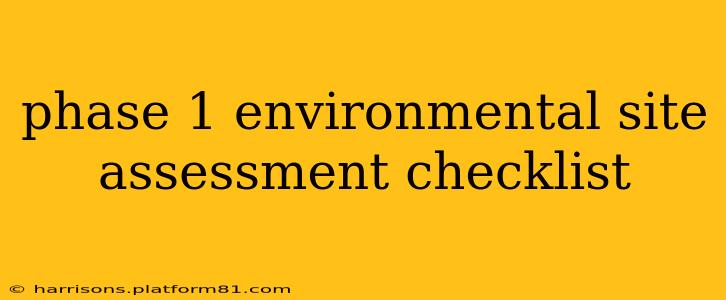A Phase 1 Environmental Site Assessment is the first step in determining potential environmental contamination on a property. This crucial process involves a thorough review of historical records and a site reconnaissance to identify potential sources of contamination. This checklist will guide you through the key elements of a Phase 1 ESA, ensuring a comprehensive and compliant assessment. It's crucial to remember that this checklist is for informational purposes only and should not be used as a substitute for professional guidance from a qualified environmental consultant. Regulations and requirements vary by location, and a professional assessment is vital to ensure compliance.
I. Historical Records Review:
This initial phase involves a deep dive into historical records to uncover any potential environmental concerns associated with the property. This often requires considerable research and attention to detail.
1. Property Records and Deeds:
- Check for: Previous owners, historical uses of the property, and any recorded environmental incidents or remediation efforts. Note any mentions of industrial activities, waste disposal, spills, or other potential sources of contamination.
- Source: County recorder's office, local government agencies.
2. Sanborn Maps:
- Check for: Historical building footprints, infrastructure, and potential uses that might indicate past environmental hazards (e.g., dry cleaners, gas stations, industrial facilities).
- Source: Local libraries, historical societies, online archives.
3. Aerial Photographs:
- Check for: Changes in land use over time, the presence of past structures or infrastructure that could be associated with environmental hazards, and evidence of potential spills or contamination.
- Source: Local government agencies, aerial photography companies, online archives.
4. Environmental Databases (e.g., EPA databases, state environmental databases):
- Check for: Reported environmental incidents, spills, releases, or cleanup activities on or near the property. These databases provide a valuable historical perspective.
- Source: EPA website, state environmental agency websites.
5. Interviews with Previous Owners, Occupants, and Neighbors:
- Check for: First-hand accounts of past activities on the property, potential environmental incidents, or any observations of unusual conditions. This can provide invaluable qualitative data.
- Source: Direct communication, potentially through property management companies or local residents.
II. Site Reconnaissance:
After reviewing historical records, a physical inspection of the property is conducted to identify potential environmental concerns.
1. Visual Inspection of the Property:
- Check for: Visible signs of contamination, such as staining, unusual odors, leaking underground storage tanks (USTs), or the presence of hazardous materials. Note the presence of any environmental features like wetlands or sensitive habitats.
- Source: On-site observation.
2. Assessment of Current Uses and Activities:
- Check for: Current land use, potential sources of contamination related to the current operations, and any potential environmental risks associated with these activities.
- Source: On-site observation, interviews with current occupants.
III. Reporting and Conclusions:
The final step involves compiling all the information gathered into a comprehensive report.
1. Report Compilation:
- Summarize: All findings from the historical records review and site reconnaissance. Clearly document all observations, data sources, and any identified potential environmental concerns.
- Assessment of potential risks: Categorize and evaluate identified concerns based on their potential environmental impact.
- Recommendations: Outline further steps necessary, such as Phase II ESA or other environmental investigations.
2. Regulatory Compliance:
- Ensure: The assessment is conducted in accordance with applicable federal, state, and local regulations, including the ASTM E1527-13 Standard Guide for Environmental Site Assessments: Phase I Environmental Site Assessment Process.
Frequently Asked Questions (FAQs)
What is the purpose of a Phase 1 Environmental Site Assessment?
A Phase 1 ESA helps identify potential or actual environmental contamination on a property. It’s typically required before buying, selling, or financing a property, providing due diligence and mitigating future liability.
How long does a Phase 1 ESA take?
The duration varies, depending on property size, complexity, and the availability of historical records. It can range from a few weeks to several months.
Who conducts a Phase 1 ESA?
A qualified environmental professional (QEP) with specific expertise in environmental site assessments should conduct the assessment.
What if contamination is found during a Phase 1 ESA?
If potential contamination is identified, a Phase II ESA (more detailed investigation) will likely be necessary to confirm and quantify the extent of contamination.
Is a Phase 1 ESA legally required?
While not always legally mandated, it's often a contractual requirement for real estate transactions, especially for commercial properties. It also protects against potential liability.
This comprehensive checklist offers a structured approach to conducting a Phase 1 ESA. Remember that this is for informational purposes only, and professional guidance is essential for accurate and compliant assessments. Consulting with a qualified environmental professional is crucial to ensure your project meets all necessary requirements and standards.
